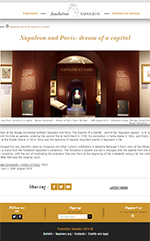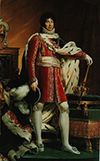| |
| |
A SITE FOR THE FONDATION NAPOLEON
We are proud to announce opening of the new website for the Fondation Napoléon: www.fondationnapoleon.org.
Unlike napoleon.org, the new website presents just the Fondation itself, giving details of its internal structure (Board of Directors, The Team, The Offices at "No 7"), its missions and services, and its partnerships with museums and other institutions, both cultural and academic.
The structure of Fondationnapoleon.org matches the Fondation's four main spheres of activity, namely:
Sharing the History (napoleon.org, Napoleon's Correspondence – the volume for 1811 is due out in November! – and the “Cercle d'études” lecture series),
Furthering Research (the Bibliothèque M-Lapeyre and digital libraries, the websites “Napoleonica - La Revue” and “Napoleonica.org - les archives”, the Fondation's annual awards and scholarships, the “Chaire Napoleon” at ICES),
Preserving the Heritage (Patronage, the St Helena fundraising operation 2010-2014), and...
Sharing the Collection (presentation of the Fondation's masterpieces and its exhibitions - with slide shows - and an on-line catalogue of the collection).
Working documents and press releases are also available for professionals (publishers, the press or museums).
Keep up to date with Fondation Napoléon activities and follow us on your smartphone and tablet too!
Irène Delage
Head of Documentation, Public Relations and IT at the Fondation Napoléon

|
|
|
| |
DEATH OF CLAUDE DURAND, FORMER CEO OF FAYARD PUBLISHERS AND FAITHFUL FRIEND OF THE FONDATION NAPOLEON
Claude Durand, author and leading figure of the French publishing world, passed away in the night of 6 - 7 May at the age of 76. He had directed the the prestitugious French publishing house Editions Fayard for nearly 30 years. He was well known for having introduced the French public to the author Gabriel Garcia Marquez and for having published Alexander Solzhenitsyn and Ismail Kadaré. But French history buffs will not forget that he was also the promoter of Fayard's major biographies series with the specific soft/hard cover, by celebrated authors such as Jean Tulard, Thierry Lentz and Pierre Branda, edited by Denis Maraval. Finally, it was Claude Durand who in 2003, together with the Fondation Napoléon, launched the publication of the General Correspondence of Napoleon.
To his family and friends, the Fondation Napoléon extends its deepest condolences. Volume XI of the "Correspondence", to be published this autumn, will be dedicated to him.

|
|
|
| |
ARTICLE OF THE MONTH > WATERLOO - BIAS, ASSUMPTIONS, AND PERSPECTIVES
Our article of the month this time around is Douglas Allan's article on the Battle of Waterloo and the disinformation that surrounds it. Taking a look at the different first-hand reports and records available to the historian, Allan investigates the events of the battle and attempts to shed some light on the various "inaccuracies" that have become associated with the combat that put an end to the First Empire.
Our article of the month in French is LE CHAMP DE MAI, 1ER JUIN 1815 (by Jean TULARD).
CERCLE D'ÉTUDES LECTURE AT THE FONDATION NAPOLEON > MURAT SEEN THROUGH THE EYES OF ALEXANDRE DUMAS
On Tuesday 2 June Claude Schopp and Professeur Jean Tulard will be giving a talk at the Fondation Napoléon in Paris entitled “Murat vu par Alexandre Dumas” (in partnership with the “Amis d'Alexandre Dumas” society) as part of our lecture séries “Cercle d'Etudes”. If you would like to take part, inscriptions will open on 19 May (see here for more information in French).

|
|
|
| |
EXHIBITION > "MURAT, KING OF NAPLES, AT THE CHARGE!"
From 19 May to 29 September, the Palazzo Reale of Naples is hosting an exhibition about the King of Naples and brother-in-law of Napoleon I, Joachim Murat, entitled “Murat re di Napoli. A passo di carica”. For this event, the Fondation Napoléon is lending a print after a painting by Vernet, a monogrammed Chaimberlain's key belonging to Joachim Murat, a portrait of Caroline Murat by Duncker, two miniatures of Joachim Murat and his children by Isabey, as well as some military figurines by Sandre.
INTERNATIONAL CONFERENCE > “MURAT, NAPOLI E L'EUROPA”,
On this occasion an international conference will be held in Naples, Italy, this week 19-20 May, on the theme of "Murat, Naples and Europe" with the participation of many international scholars. Talks will be given in French and Italian.

|
|
|
| |
 |
 |
LOST PAINTING BY INGRES, WHICH ONCE BELONGED TO THE MURATS, MAY HAVE BEEN FOUND. For years historian Véronique Burnod has been searching for the painting “La Dormeuse”, by Ingres, which disappeared after the Murats' fall from power in Italy (see our paragraph 200 years ago, below). She now believes it lies hidden beneath another painting attributed to the Neapolitan painter Luca Giordano (1634-1705), a work belonging to the Museum of Capodimonte. In an article due to appear soon in the Bulletin des Amis du Musée Ingres de Montauban, Burnod describes how a series of 1,650 multispectral images of the painting realised in 2014 show that in the lower layers of the painting, the forms and volumes of the “dormeuse” can clearly be seen as well as the signature of Ingres; several studies as well as copies made by Ingres (who was obsessed with the painting) exist - cf photo above: Sleeping Odalisque, a study by Ingres after "la Dormeuse de Naples". Caroline Murat (the sister of Napoleon I), who it was erroneously believed was herself represented as the “dormeuse”, loved the painting and even commissioned a matching work from Ingres, the well-known orientalist nude “La Grand Odalisque”, which Ingres was able to retrieve and which now belongs to the Louvre. Read several recent articles in the French press on the subject.

|
|
|
| |
OPERA > UTHAL DE MEHUL AT THE OPERA ROYAL DE VERSAILLES
The opera “Uthal” by Etienne-Nicolas Méhul (1763-1817) was premiered on 17 May 1806. Based on a libretto inspired by the writings of Macpherson, a supposedly ancient Scottish poet particularly admired by Napoleon, the opera, which is rarely performed today, will be given in a concert version at the Chateau de Versailles near Paris in France, on 30 May 2015. There is also to be a recording. (Painting: Le songe d'Ossian, by Ingres, 1813).
200 YEARS AGO > THE END OF THE REIGN OF MURAT IN NAPLES.
When the first failures of Murat's "campaign" became known (cf. Bulletin No 758), the King of Naples transferred his authority to his wife, Caroline, who had remained in Naples, in order that she contain rumours and defend the city. On becoming regent on the 18 April, Caroline had not only the Neapolitan population to fear, but also foreign invaders. Captain Robert Campbell, commander of two ships and two frigates, who had arrived near the Bay of Naples on April 26, was to order Napoleon's sister to surrender. Unable to resist the advance of the Austrians and the siege of the British, Caroline was able to secure Campbell's word that members of her family present at the palace - Madame Mère, Cardinal Fesch, Jerome and his own children – could take refuge in Gaeta. The British fleet had forced the latter to return to port when they tried to reach Toulon on board the vessels Joachim and Capri. On 12 May, an agreement was signed between Campbell and Prince Cariati, Caroline's representative, that the fleet and arsenals of Naples would be surrendered to the besiegers, while Caroline would be allowed take refuge under British protection at the property of her choice and to join her children and be taken to a port in Provence at her convenience. Confronted with the rumour of the rout of Murat's troops, Caroline showed composure and prevented the palace from being taken. On 16 May, the Austrians crushed Marshal Macdonald and his troops at San Germano. Amid the chaos, Murat was able to pass quietly through Naples on the 19th, in order to bid farewell to his wife. The next day, two of their envoys were negotiating the surrender of the kingdom with Austria, whilst the fallen Queen of Naples took refuge under the British flag on Campbell's ship, Tremendous. On the 22nd May, the Austrian commander, Neipperg, entered Naples and demanded that Caroline be handed over, despite her prior agreements with the British and the Austrians. Taken prisoner, Napoleon's sister would never see her husband again.
150 YEARS AGO > CREATION OF THE INTERNATIONAL TELEGRAPH UNION
France of the two Napoleons was profoundly affected by telegraphic communication. Claude Chappe's network of gigantic semaphore stations transmitted in relatively ‘lightning speed' the news of the victory of Austerlitz in 1805. Morse code was soon to surpass the unwieldy semaphore stations, and by the Second Empire, Europe and Britain were to be linked by a telegraph wire laid along the sea bottom in 1850, with a regular service being inaugurated the following year. Furthermore, Napoleon III was to be an adept of the new technology directing via telegraph from his war office in Paris the Italian campaign in Piedmont of 1860. He also struck a deal with Paul Julius Reuter for the simultaneous transmission of his speech announcing the war with Austria to the London Parliament, precisely at the moment he was giving it in Paris.
And just as river use had stimulated the Vienna Congress of 1815 in the time of Napoleon I to lay down the first foundations of International Law, so transnational cables in that of Napoleon III were to pose the similar legal questions. Following in the wake of the International Postal Conference of 1863 (see Bulletin no. 673), representatives of twenty European states met in Paris for the International Telegraph Conference in the spring of 1865, the result being the first ever International Telegraph Convention, signed on the 17 May, thereby standardising internationally telegraphic equipment, setting uniform operating instructions and laying down common international tariffs and accounting rules. This conference and convention was the ancestor of today's ITU (or International Telecommunication Union), the United Nation's specialised telecommunications agency.
Wishing you an excellent Napoleonic week!
Peter Hicks and Rebecca Young
THE NAPOLEON.ORG BULLETIN No. 759, 15 - 21 MAY, 2015
Interested in the work of the Fondation Napoléon? Why not participate, either generally or in a specific project, by making a donation?
© This Napoleon.org weekly bulletin is published by the Fondation Napoléon. Reproduction or all or part of this bulletin is forbidden, without prior agreement of the Fondation Napoléon.

|
|
|
|
|
|
|
|
WATERLOO BICENTENARY 1815-2015
What's on this year relating to the Bicentenary of the Battle of Waterloo: commemorations, books, exhibitions, news ...
WATERLOO > WHAT'S ON (updated 15/5/15)
WATERLOO > SEEN ON THE WEB (updated 15/5/15)
WATERLOO > READING LIST (updated 15/5/15)
Follow us on Facebook and on Twitter!
napoleon.org - related content:
WHAT'S ON (see our website for all events)
Talks
- - Andrew Roberts and Jenny Uglow in conversation about Waterloo, Charleston Festival, UK [16/05/2015]
- "Waterloo 1815: The Image and the Battle", Brown University, Providence, USA [23/05/2015]
- Waterloo and Wellington: Lecture Series, Apsley house, London [05/05/2015 - 21/06/2015]
- "Battle of Waterloo: A Defining Moment", by Paul Chamberlain, Peterborough, UK [29/05/2015]
- "The Hundred Days: Napoleon's Road from Elba to Waterloo", by Mark Adkin, Army & Navy Club, London [11/06/2015]
- "Napoleon the Great", by Andrew Roberts, British Museum [19/06/2015]
- Battle of Waterloo Commemorative Walks in London, UK [21/03/2015 - 20/06/2015]
Conferences
- Murat, Naples and Europe, Naples, Italy [19/05/2015 - 20/05/2015]
- International congress “From Battlefield to Drawing Room: textile and (military) fashion around 1815” Brussels, Belgium [10/06/2015 - 12/06/2015]
- 'Waterloo Revisited' Bomann-Museum, Celle, Germany [12-13/06/2015]
- 'Popular Reactions and State Responses to the 100 Days' University of Warwick, UK [07/07/2015]
- 'Die Schlacht von Waterloo 1815 und die deutschen Truppen' Bomann-Museum, Celle, Germany [19/09/2015]
Exhibitions
- '"A damned serious business": Waterloo 1815, the battle and its books' Cambridge University Library, UK, and online [01/05/2015 - 16/09/2015]
- 'Wellington and Waterloo: "the tale is in every Englishman's mouth"' University of Southampton Library, UK [13 April -19 June and 13-24 July 2015]
- 'The Road to Waterloo' and ‘Waterloo Lives' Gordon Highlanders Museum, Aberdeen, Scotland [03/02/2015 - 28/11/2015]
- 'Waterloo' at the Bomann-Museum, Celle, Germany [02/04/2015 - 11/10/2015]
- 'Napoleon und Bayern' Bayerisches Armeemuseum, Ingolstadt, Germany [30/04/2015 - 30/10/2015]
- 'Napoléon Ier ou la légende des Arts, 1800 –1815' Compiègne, France [24/04/2015 - 27/04/2015]
- 'Waterloo 1815 - The Battle for Peace' at Wellington Arch and new display at Apsley House London UK [18/04/2015 - 30/12/2015]
- 'Cap sur l'Amérique - La dernière utopie de Napoléon' Chateau de Malmaison, France [22/04/2015 - 20/07/2015]
- 'Napoléon et Paris, rêves d'une capitale' Musée Carnavalet, Paris [08/04/2015 - 30/08/2015]
- 'Le congrès de Vienne, l'invention d'une Europe nouvelle' Musée Carnavalet, Paris, France [08/04/2015 - 30/07/2015]
- 'Napoléon-Wellington: Destins Croisés' Wellington Museum, Waterloo, Belgium [21/03/2015 - 31/07/2015]
- Waterloo 1815-2015: Visions of war' Bibliothèque Paul Marmotton, Paris, FR [15/04/2015 - 11/07/2015]
- 'Pie VII face à Napoléon: la Tiare dans les serres de l'Aigle' Fontainebleau, FR [28/03/2015 - 29/06/2015]
- 'Alexander, Napoleon and Josephine: a story of war, art and friendship' Hermitage, Amsterdam, NL [28/03/2015 - 08/11/2015]
- 'Modern Heroism: Printmaking and the legacy of Napoleon Bonaparte' Fitzwilliam Museum, Cambridge UK [03/02/2015 - 28/06/2015]
Commemorations
- Commemorations of the battle of Albuera in Portugal and Spain [14/05/2015 - 16/05/2015]
- La Route du Prince Impérial, Louis Napoléon, French week and concert, South Africa [24/05/2015 - 30/05/2015]
- Major Percy victory route (recreated by bike): The Ride of the Lions, Waterloo 200 [17/06/2015 - 20/06/2015]
WATERLOO > WHAT'S ON (updated 15/5/15)
SEEN ON THE WEB (all external links)
- Exhibition at Alnwick Castle, UK, to tell the story of Major Henry Percy's dash from the Battle of Waterloo to London
- From Waterloo to Gallipoli - one Scots family's story
- letter from cousin of William Wordsworth who met Napoleon Bonaparte on Elba
- Artworks from French voyage to Australia in 1800s to go on show in Australian museums
- Built in the 1860s to fend off Napoleon III's warships, No Man's Fort
- ‘Napoleon' map gives a tantalising clue to the past
Rare find in German library reveals details of Filfla, aqueduct and reef
"WATERLOO" > SEEN ON THE WEB (link to our website, updated 15/5/15)
THE BIBLIOTHÈQUE MARTIAL-LAPEYRE FONDATION NAPOLEON LIBRARY
The library is normally open on Mondays and Tuesdays from 1pm to 6pm and on Thursdays and Fridays from 10am to 3pm. The library is closed on Wednesdays.
Online database catalogue
Digital Library
Contact
NAPOLEONICA LES ARCHIVES
Site of digitised Napoleonic archival material:
The working papers or 'imprimés' of the Napoleonic Conseil d'Etat, the correspondence of Vivant Denon, etc.
http://www.napoleonica.org
Contact: napoleonica@napoleon.org
NAPOLEONICA. LA REVUE
International peer-review interdisciplinary e-review on the history of the two Empires, bilingual French-English, 3 issues per year, free access.
Read the review on Cairn.info
Contact: napoleonicalarevue@napoleon.org
The Fondation Napoléon's Institutional website:
www.fondationnapoleon.org
ACCOUNT DETAILS
To change your email address, unsubscribe, and sign up for the French information bulletin.
Problems with a link in this letter?
- Check the homepage on: http://www.napoleon.org/en/home.asp
- View back numbers of the bulletin: http://www.napoleon.org/en/space/information_bulletin/archive_lettre.asp
- Contact us: information@napoleon.org
|
|







